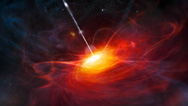What Is Gravity Made Of?
- By Greg Kestin
- Posted 05.08.14
- NOVA
One of the most incredible physics discoveries of the century has revealed a "cosmic fingerprint" explaining the beginning of universe and gravity's microscopic secrets. Go back to the beginning of time to see how quantum particles in the infant universe gave rise to a phenomenon called "inflation." This new evidence tells not only why the universe exploded outward during its birth, but also that gravity is made of quantum particles, called gravitons.
Transcript
What Is Gravity Made Of?
May 8, 2014
One of the most incredible and surprising physics discovery of this century was just made by a team of scientists based at the South Pole, operating a telescope, called BICEP2.
They found a celestial fingerprint that not only explains the explosive beginning of time, but also reveals gravity's microscopic secrets. To understand what this fingerprint is, imagine turning back the cosmic clock to just after the big bang, when the universe was crowded into a hot, dense ball over a billion times smaller than an atom's nucleus.
For decades, physicists have wondered what laws of nature would dominate here; the tiny size of the universe meant the seething, ethereal world of quantum particles should be at play, but the immense mass meant the space-bending world of gravity should also be at work.
So the physicist merged these worlds, and came up with a strange idea. They proposed that gravity is actually made of quantum particles, which they called "gravitons." Anywhere there is gravity, there would be gravitons: on earth, in solar systems, and most importantly in the miniscule infant universe where quantum fluctuations of gravitons sprung up, bending pockets of this tiny space-time. But if gravitons are everywhere, why can't we see them?
Unfortunately, a single graviton is too measly to detect, so we had no evidence of them. But scientists made another assumption about the moment after the big bang. They proposed that in this tiny cramped ball, instead of gravitational attraction between matter, there would have been a fierce gravitational repulsion, which would have caused everything to explode outward in a momentary event called "inflation." During inflation, the once tiny graviton fluctuations also inflated into large gravitational waves.
In the following, infant, years of the universe, photon particles of light and charged particles were so crowded in space that they were constantly colliding, meanwhile the gravitational waves stretched and contracted parts of space, causing cold spots and hot spots to form.
Where these spots met, photons ricocheting off charge particles became aligned and together all these photons produced distinct patterns in the cosmic glow. Around 380,000 years after the big bang, the universe becaÂme so large and all the particles were so spread out that the collisions stopped, and the final patterns of light streamed out through space, where we can see them today.
The swirls in these twisting patterns of light are called "b-modes", and they are the fingerprint that the scientists found. They're the first direct evidence for the inflation or explosion that birthed our universe and the strongest evidence we've ever had that gravity is, in fact, made of tiny particles, called gravitons.
Credits
PRODUCTION CREDITS
- Produced, animated, and edited by
- Greg Kestin
- Editorial help from
- Anna Rothschild and Kate Becker
- Written and researched by
- Greg Kestin
- A special thanks to:
- Colin Bischoff
Andrew Friedman
Anna Ijjas - Original Footage
- © WGBH Educational Foundation 2014
MEDIA CREDITS
- MUSIC
- Frost Waltz by Kevin MacLeod (incompetech.com) (CC BY 3.0)
IMAGE
- (main image: Earth and gravitons)
- © WGBH Educational Foundation 2014
- (Bicep2)
- Courtesy National Science Foundation
- (Big Bang & Galaxies)
- Courtesy NASA
Related Links
-

The Fabric of the Cosmos
Acclaimed physicist Brian Greene reveals a mind-boggling reality beneath the surface of our everyday world.
-

Dimensions of Our Universe
Discover why physicists think our universe may have ten dimensions—or more.
-

The Universe Made Me Do It
An inside look at a proposal to test quantum mechanics and "free will" using distant quasars.
-

The Elegant Universe
Eleven dimensions, parallel universes, and a world made out of strings. It's not science fiction, it's string theory.

